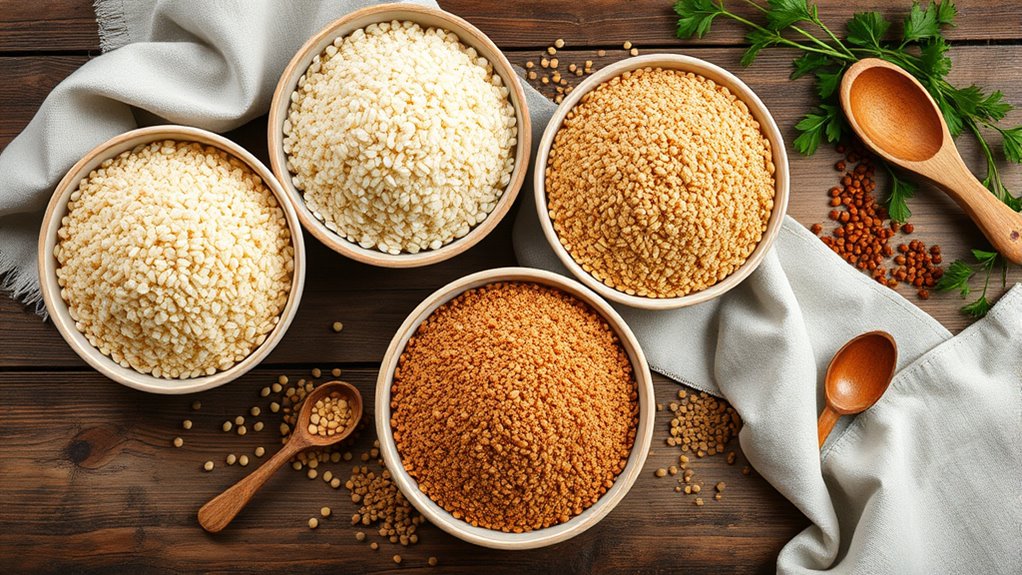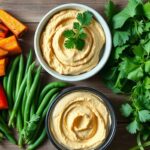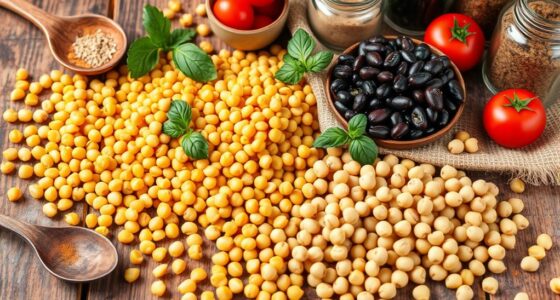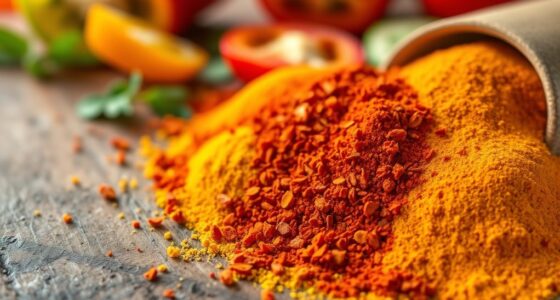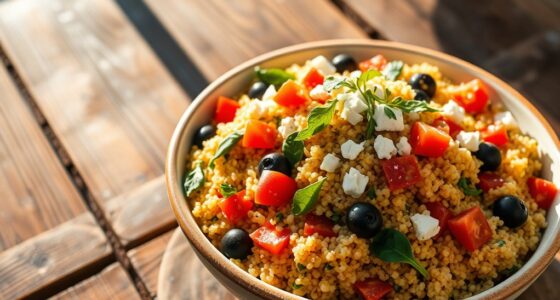To streamline your ancient grain meal prep, cook quinoa, farro, and teff in advance and store them in airtight containers. Rinse each thoroughly before cooking to remove bitterness and dirt. Use a 2:1 water-to-grain ratio for fluffy quinoa, soak and cook farro based on its variety, and toast teff for richer flavor. Combine these grains with vegetables, proteins, and herbs for versatile meals throughout the week. Keep exploring for more tips to maximize their nutritional benefits and flavor.
Key Takeaways
- Cook large batches of quinoa, farro, and teff to streamline meal prep and store in airtight containers for convenience.
- Rinse quinoa and teff thoroughly before cooking to remove bitterness and impurities, ensuring better flavor and texture.
- Use appropriate water ratios and cooking times: 15 minutes for quinoa and teff, 20-45 minutes for farro, depending on type.
- Incorporate grains into salads, bowls, or side dishes by mixing with vegetables, herbs, and lean proteins for balanced meals.
- Toast grains like teff lightly to enhance flavor and diversify meal options with porridge, soups, or grain-based salads.
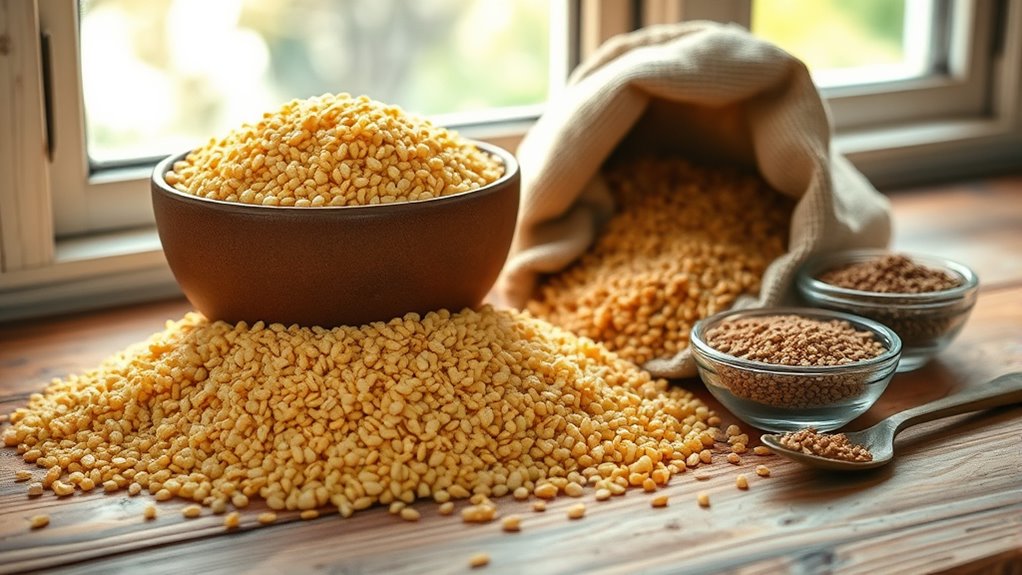
Ancient grains are making a comeback as a nutritious and versatile addition to your meal prep routine. These grains, like quinoa, farro, and teff, offer a unique way to boost your meals with wholesome ingredients that pack a punch of nutritional benefits. Incorporating these grains into your weekly plan can add variety, flavor, and health benefits that traditional grains might lack. Quinoa, for instance, is a complete protein, meaning it contains all nine essential amino acids, making it an excellent choice for plant-based diets. Farro provides a good source of fiber, vitamins, and minerals, supporting digestion and overall wellness. Teff is rich in calcium, iron, and protein, contributing to strong bones and increased energy levels. When you start cooking with these grains, understanding their nutritional benefits can motivate you to experiment more often.
Cooking tips are crucial when working with ancient grains, especially if you’re new to them. Quinoa cooks quickly—about 15 minutes—so rinsing it thoroughly before cooking is essential to remove its natural saponins, which can taste bitter. Using a 2:1 water-to-quinoa ratio ensures fluffy grains. With farro, you have two options: pearled or whole. Pearled farro cooks faster, roughly 20-30 minutes, while whole farro takes closer to 45 minutes but retains more nutrients. Soaking farro beforehand can cut down cooking time and improve digestibility. Teff, being tiny and dense, requires about 15 minutes of boiling. It’s best to rinse it well to remove any dirt and to toast it lightly in a dry pan before cooking to enhance flavor.
When prepping these grains for the week, cooking large batches and storing them in airtight containers is practical. You can mix cooked quinoa with chopped vegetables and herbs for quick salads or stir-fries. Cooked farro makes a hearty base for grain bowls, salads, or side dishes. Teff, with its nutty flavor, works well in porridge or as a thickener for soups. To maximize their nutritional benefits, pair these grains with colorful vegetables, lean proteins, and healthy fats. Incorporate spices like cumin, turmeric, or paprika to elevate flavor without extra calories. Remember, these grains tend to absorb flavors well, so don’t be shy about seasoning your dishes.
Frequently Asked Questions
How Do I Store Cooked Ancient Grains Safely?
You should store cooked ancient grains in an airtight container in the refrigerator within two hours of cooking. Proper grain storage prevents bacteria growth and keeps your grains fresh. Use meal prep tips like labeling containers and dividing portions for easy access. Consume stored grains within 3-4 days, and reheat thoroughly before eating. For longer storage, consider freezing the grains in portion-sized containers to maintain freshness.
Can Ancient Grains Be Eaten Cold or Only Warm?
You can definitely enjoy ancient grains cold, like a revitalizing breeze on a summer day. Eating them cold preserves their firm, chewy texture and keeps their delicate flavor intact, like a well-preserved treasure. Whether you toss quinoa, farro, or teff into salads or enjoy them straight from the fridge, their grain texture remains appealing, and their flavor stays vibrant. So, go ahead—savor these grains chilled for a delightful, healthy treat.
Are There Gluten-Free Options Among These Grains?
Yes, quinoa and teff are gluten-free, making them excellent alternative grain options for those with gluten sensitivities or celiac disease. These grains offer gluten-free benefits, allowing you to enjoy nutritious meals without worry. Farro, however, contains gluten. Incorporate quinoa and teff into your diet to diversify your meals with wholesome, gluten-free options that support your health and taste preferences.
How Do I Prevent Ancient Grains From Becoming Mushy?
To prevent ancient grains from becoming mushy, focus on proper cooking techniques and maintaining grains’ texture. Rinse grains thoroughly before cooking to remove excess starch, which can cause sogginess. Use the right water-to-grain ratio and avoid overcooking—check for doneness early. Once cooked, let grains rest off heat, and fluff them with a fork. This helps keep their texture firm and prevents mushiness, ensuring perfect grains every time.
What Are Some Creative Flavor Pairings for These Grains?
You can elevate your ancient grains by pairing them with vegetables like roasted squash or sautéed kale, which add flavor and texture. Experiment with spice combinations such as cumin and paprika or turmeric and cinnamon to enhance their natural taste. These pairings create vibrant, satisfying dishes that keep your meals interesting. Don’t be afraid to mix and match vegetables and spices to find your perfect flavor combo!
Conclusion
Now that you’ve uncovered the secrets of ancient grains, your meals become a tapestry woven with history and health. Think of each dish as a timeless melody, nourishing your body like a gentle river flowing through centuries. As you incorporate quinoa, farro, and teff into your meal prep, you’re not just cooking—you’re summoning the whispers of ancient civilizations. Embrace these grains, and let your kitchen become a sanctuary where tradition and flavor dance harmoniously.
Ilana has been a vegan for over 10 years. She originally made the switch for health reasons, but soon found herself becoming more and more passionate about the ethical and environmental implications of a vegan lifestyle. Ilana is the author of The Graceful Kitchen, a blog all about veganism. She loves to cook up delicious and nutritious vegan meals, and share her recipes with others who are interested in leading a cruelty-free life. Ilana is also a strong advocate for using whole foods as the foundation of a healthy diet, and believes that going vegan is one of the best ways to achieve this.
